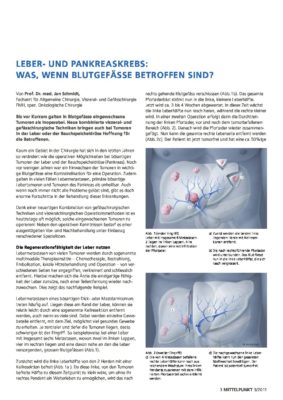Pancreas
Personally performed operations (as of 2018): 954
Total of performed visceral operations: over 14.000
Surgery of the pancreas is usually necessary for two different reasons. First of all, tumors of the pancreas, which are either malignant or precursor cells of pancreatic cancer, become more frequent. Additionally, there are benign tumors (e.g. neuroendocrine tumors).
Secondly, another common indication is the occurrence of a so-called chronic pancreatitis, which can cause severe pain and calcification of the pancreatic duct, including the formation of stones. This is mostly caused by excessive alcohol consumption.
Surgery of the pancreas
Operations of the pancreas are mainly concerned with the region of the disease. If it is located in the pancreas head, a so-called pancreatic head resection (also called the Kausch-Whipple-Operation) can become necessary. In its course, the duodenum, pancreas head, gall bladder and the surrounding lymph nodes are removed. Afterwards, the small intestine is connected with the remaining pancreas, the bile duct and the stomach.
If the tumor is located in the pancreatic tail, a so-called distal pancreatectomy is performed, mostly while also removing the spleen and surrounding lymph nodes. This operation can also be done laparoscopically, unless the tumor has spread to the surrounding organs.
Tumors that are located in the middle part of the pancreas call for a pancreatic segment resection. This procedure has the advantage of preserving the valuable pancreatic tail, which is rich in islet cells, leading to a much lower rate of diabetes.
It is however important to look at each case very carefully and plan the most appropriate individual therapy.
Possible complications
Complications following surgery of the pancreas mostly concern the freshly made connections to other organs. Digestive fluids and enzymes can leak out and start to damage the surrounding tissue. This can be dangerous, especially if the tissues concerned are blood vessels or the neighbouring intestinal tract.
Upon removal of the some parts of the pancreas (especially the pancreatic tail), islet cells are reduced. They are important to insulin production and blood sugar levels. For that reason, diabetes can occur as a consequence of the treatment.
The mortality rate of pancreatic surgery in state-of-the-art centres lies between 3 and 5 percent. Duration of hospitalisation averages 10 to 14 days. Following resection of the pancreatic tail, it can even be less.



